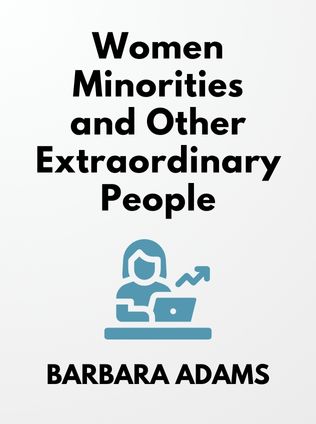
Women, Minorities, and Other Extraordinary People
The New Path for Workforce Diversity
By Barbara Adams
Published 09/2018
About the Author
Dr. Barbara Adams is a leading expert in the field of diversity, equity, and inclusion, with a rich academic background that includes a Doctorate of Psychology in Organizational Development. She is the Founder and Chief Learning Officer at GAR (Gender, Age, and Race) Diversity Consulting. Dr. Adams's work focuses on transforming workplaces to be more inclusive and equitable, and she has been featured in various prestigious publications, including The Sacramento Bee and SiliconValley.com. Her book, Women, Minorities, and Extraordinary People: The New Path for Workforce Diversity, offers insights into the systemic changes needed to foster true diversity in organizations.
Main Idea
Women, Minorities, and Other Extraordinary People: The New Path for Workforce Diversity by Dr. Barbara Adams is a comprehensive exploration of the essential role that diversity and inclusion play in the modern workplace. The book argues that diversity is not just a moral imperative but a business advantage, leading to greater innovation, financial performance, and overall company growth. Dr. Adams stresses that inclusion requires proactive efforts to ensure all employees feel valued for their unique contributions. The book provides a roadmap for organizations to create a truly diverse and inclusive environment, addressing both visible and invisible barriers to inclusion.
Table of Contents
- Acknowledging the Problem, Embracing the Opportunity
- The Problem with Unconscious Bias
- The Problem with Positive Bias
- Creating Opportunities for Diversity and Inclusion
- Reframing Your Thinking
- Looking at Your Organizational Culture
- A Framework for Thinking about Differences
- Critical Thinking
- Making a Plan Like No Other
- Finding the Right Talent
- Enhancing the Hiring Process
- Retaining and Engaging Employees
- Learning to Navigate the Difference
- Conversations that Shift Thinking
- Assessing Your Company’s Readiness
- Determining Your Own Self Readiness
Acknowledging the Problem, Embracing the Opportunity
Dr. Adams begins by discussing the importance of acknowledging the lack of diversity in many organizations as a critical step toward meaningful change. She argues that simply having diversity policies is not enough; organizations must actively work to understand and address the root causes of their diversity issues. According to Dr. Adams, the absence of diverse perspectives leads to missed opportunities for innovation and growth. She writes, "When we don’t work toward change, we’re unable to benefit from the differences, innovations, and advancements that women and minorities could bring to our companies."
The author highlights that organizations often fail to see the business benefits of diversity, such as enhanced creativity and improved problem-solving abilities. She points to research showing that companies with higher gender and ethnic diversity are more likely to outperform their peers. Dr. Adams urges leaders to view diversity not as a compliance issue but as a strategic advantage that can drive competitive differentiation and business success.
The Problem with Unconscious Bias
Unconscious biases are automatic, deeply ingrained mental shortcuts that influence our perceptions and decisions without our conscious awareness. Dr. Adams explains that these biases can lead to discriminatory practices in hiring, promotions, and daily workplace interactions. For example, unconscious bias may cause hiring managers to favor candidates who resemble themselves in terms of race, gender, or background, thereby perpetuating homogeneity within the organization.
Dr. Adams emphasizes the need for organizations to recognize and mitigate the effects of unconscious bias. She suggests implementing training programs to increase awareness and understanding of these biases, as well as employing structured decision-making processes to reduce their impact. She states, "Culture and society hold strong influences on biases and beliefs. When certain groups are more associated with good things and other groups with bad things, people unwittingly believe these associations." By challenging these automatic associations, organizations can begin to create a more equitable and inclusive environment.
The Problem with Positive Bias
While much attention is given to negative biases, Dr. Adams also discusses the detrimental effects of positive biases. Positive biases occur when certain groups or individuals are favored based on stereotypical perceptions of their capabilities or qualities. For example, assuming that a particular gender or ethnic group is inherently better suited for certain roles can lead to an overrepresentation of that group in those roles, excluding others who may be equally or more qualified.
Dr. Adams argues that positive biases can be just as harmful as negative ones, as they reinforce stereotypes and limit opportunities for underrepresented groups. She provides an example from her own experience: when her alma mater solicited donations, she chose to also donate to the United Negro College Fund, recognizing the importance of supporting underrepresented communities. She writes, "Imagine if alumni donors from every institution of higher education also donated to organizations serving underrepresented communities. Powerful change could occur." This act of rethinking where resources are allocated highlights the importance of addressing positive biases to create a more inclusive society.
Sign up for FREE and get access to 1,400+ books summaries.
You May Also Like
The Subtle Art of Not Giving a F*ck
A Counterintuitive Approach to Living a Good Life
By Mark MansonRich Dad Poor Dad
What the Rich Teach Their Kids About Money - That the Poor and Middle Class Do Not!
By Robert T. KiyosakiHow To Win Friends and Influence People
The All-Time Classic Manual Of People Skills
By Dale CarnegieQuiet: The Power of Introverts
The Power of Introverts in a World That Can't Stop Talking
By Susan Cain



















